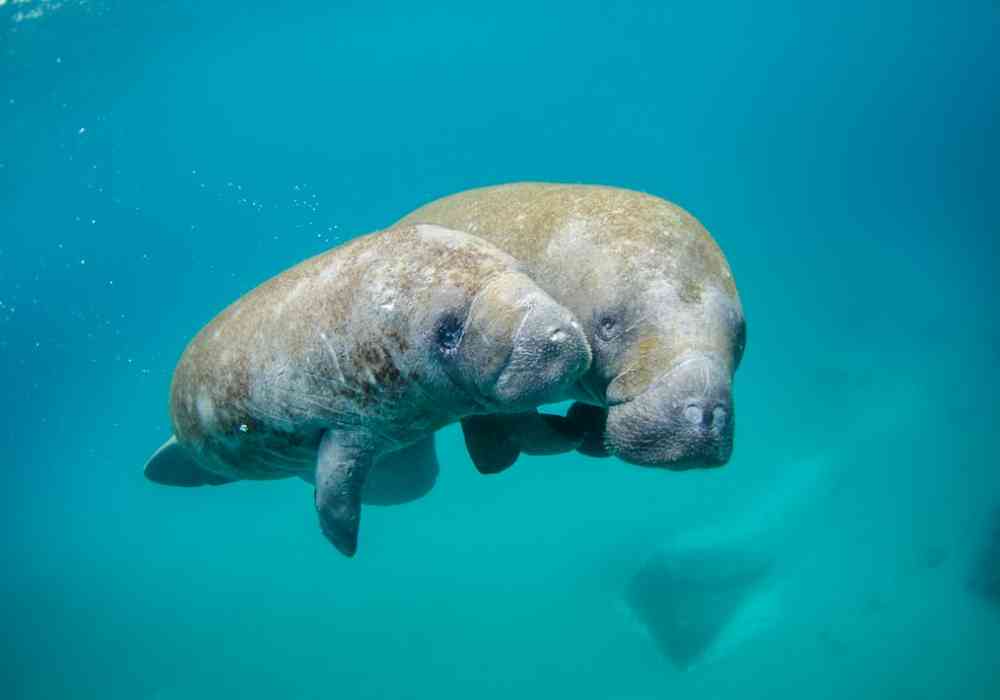Exploring the Lifespan of Manatees: A Comprehensive Guide
How long do manatees live? This charming question leads us to one of nature’s gentle giants. Manatees, also known as sea cows, have an average lifespan of up to 60 years in the wild, although many face challenges that significantly reduce this number. Unfortunately, research suggests that many of these serene creatures rarely reach their full potential lifespan due to threats like habitat loss and human activities.
Manatees spend their days grazing on seagrass, resting in warm waters, and occasionally surfacing for air. Despite their calm, slow-paced lifestyle, their population is under constant threat. Conservation efforts are essential in protecting these creatures and ensuring they continue to grace our waters for generations to come.
I’m Chris Higgins, and as a graphic artist with a passion for manatees, I’ve digd into understanding links between manatee lifespan and conservation efforts. Let’s explore how preserving these remarkable mammals is vital for their future survival.
How Long Do Manatees Live?
Manatees, those gentle giants of the sea, have the potential to live quite long lives. In the wild, manatees can live between 50 to 60 years. However, due to various challenges, many don’t reach this age. Human activities and environmental changes often shorten their lifespan significantly.
In captivity, manatees can live even longer. With proper care and a safe environment, they can surpass 65 years. A famous example of this is Snooty, the world’s oldest manatee, who lived to the ripe age of 69. Snooty was born and raised in captivity at the Miami Aquarium and Tackle Company, and he became a beloved symbol of what proper care and protection can achieve.
Challenges in the Wild
Despite their potential for longevity, many manatees face challenges that hinder their ability to live long lives in the wild. Factors such as habitat destruction, watercraft collisions, and pollution pose significant threats. It’s estimated that many manatees don’t live beyond ten years due to these dangers.
Captivity as a Safe Haven
Captivity provides a controlled environment where manatees can avoid some of the dangers they face in the wild. Facilities that house manatees ensure they have access to adequate food, medical care, and protection from human-induced threats. This setting allows them to thrive and reach an age they might not achieve in their natural habitat.
The story of Snooty is a testament to the potential longevity of manatees when they are cared for in a nurturing environment. His long life has inspired many to advocate for the conservation and protection of manatees worldwide.
Understanding how long do manatees live and the factors that influence their lifespan is crucial. By addressing these challenges, we can work towards a future where more manatees live long, healthy lives.
Factors Affecting Manatee Lifespan
Manatees are fascinating creatures with the potential to live long, fulfilling lives. However, several factors influence their lifespan, both positively and negatively. Let’s explore these factors:
Natural Causes
In the wild, manatees face natural challenges that can affect their lifespan. Temperature plays a critical role. Manatees need warm water to survive, ideally above 68 degrees Fahrenheit. Exposure to colder temperatures can cause “cold stress,” leading to disease and even death.
Additionally, manatees are vulnerable to natural events like red tides. These toxic algal blooms can be deadly. In 1996, a red tide in southwest Florida resulted in the deaths of around 150 manatees. These natural causes highlight the delicate balance manatees must maintain in their environment.
Human Impact
Human activities significantly impact manatee lifespan. One of the most pressing threats is watercraft collisions. Manatees are slow swimmers and often don’t have time to avoid fast-moving boats. In 2020, at least 90 manatee deaths were attributed to watercraft accidents.
Pollution is another major concern. Manatees often ingest debris like plastic bags, which can lead to severe health issues or death. The tragic case of Emoji, a young manatee who died after ingesting plastic, underscores the deadly impact of pollution.
Moreover, manatees are sometimes victims of poaching and harassment, despite legal protections. These unlawful activities further threaten their survival.
Habitat Loss
Manatees rely on specific habitats for food and shelter. Habitat destruction due to human development reduces the availability of these essential resources. As humans expand into natural areas, manatees lose their homes and food sources.
Additionally, the decline in sea grass, a primary food source for manatees, poses a significant threat. Efforts are being made to restore sea grass habitats, but the loss remains a critical issue.
Understanding these factors is key to protecting manatees and ensuring they live long, healthy lives. By addressing both natural and human-induced challenges, we can help secure a brighter future for these gentle giants.
Threats to Manatee Survival
Manatees face numerous threats that jeopardize their survival. These threats primarily stem from human activities and environmental changes. Let’s dig into the key dangers manatees encounter:
Watercraft Collisions
One of the most significant threats to manatees is collisions with watercraft. These gentle giants are often victims of boat strikes due to their slow movement and the need to surface for air. In 2020 alone, at least 90 manatees died from watercraft accidents. Manatees’ dark coloring and slow swimming speed make it hard for boaters to spot them in time. This issue highlights the need for boaters to follow speed limits and be vigilant in manatee habitats.
Pollution
Pollution is another critical issue affecting manatees. These creatures often ingest or get entangled in debris like plastic bags and fishing lines. Such pollution can lead to severe health complications, infections, or even death. A tragic example is the story of Emoji, a two-week-old manatee found with plastic in his stomach. Despite efforts to save him, Emoji passed away, underscoring the deadly impact of pollution on manatees.
Poaching
Despite legal protections, manatees still fall victim to poaching and harassment. Some individuals hunt them for food or harass them for entertainment, disregarding the laws designed to protect these vulnerable animals. Such illegal activities further threaten their already declining population and highlight the need for stricter enforcement of protective regulations.
Habitat Loss
Manatees depend on specific habitats for survival, primarily areas rich in sea grass. However, habitat destruction due to human development and environmental changes poses a significant threat. As humans encroach on natural habitats, manatees lose vital food sources and shelter. Efforts like the Save Crystal River Project aim to restore sea grass, but habitat loss remains a pressing concern.
Understanding and addressing these threats is crucial for the conservation of manatees. By supporting conservation efforts and raising awareness, we can help protect these gentle giants and ensure their survival for generations to come.
Conservation Efforts and Protection
In response to the threats faced by manatees, several laws and initiatives have been established to protect these gentle creatures. These efforts aim to preserve their habitats and ensure their survival for future generations.
Florida Manatee Sanctuary Act
The Florida Manatee Sanctuary Act of 1978 designates the entire state as a sanctuary for manatees. This law is crucial in protecting manatees from harassment and harm. It enforces strict regulations on boating speeds in manatee habitats, reducing the risk of watercraft collisions. Violations can lead to hefty fines and even imprisonment, emphasizing the seriousness of manatee protection.
Marine Mammal Protection Act
The Marine Mammal Protection Act of 1972 is a federal law that safeguards all marine mammals, including manatees, from hunting, capture, and harassment. This act plays a vital role in maintaining healthy manatee populations by prohibiting any activities that could harm them. It also supports research and rescue efforts, ensuring that distressed manatees receive the care they need.
Endangered Species Act
The Endangered Species Act of 1973 classifies manatees as a threatened species. This designation provides them with additional protections, including habitat conservation and restoration efforts. The act mandates the development of recovery plans to address the threats manatees face, such as habitat loss and pollution. These plans involve collaboration between federal and state agencies to monitor and improve manatee habitats.
Collaborative Conservation Efforts
Beyond legislation, organizations like the Save the Manatee Club and the Everglades Foundation work tirelessly to protect manatees. They focus on research, public education, and habitat restoration. For example, the Everglades Foundation aims to restore the natural flow of water in the Everglades, which benefits manatee habitats by improving water quality and increasing sea grass availability.
These conservation efforts are essential for the survival of manatees. By supporting these initiatives and adhering to protective laws, we can help ensure a safer and healthier environment for manatees to thrive.
Frequently Asked Questions about Manatee Lifespan
How old is the oldest manatee?
The oldest known manatee, Snooty, lived to the impressive age of 69 years. Snooty was born in captivity at the Miami Aquarium and Tackle Company and spent his entire life under human care at the South Florida Museum. His long life is a testament to the potential lifespan of manatees when they are protected from natural and human-related threats.
What is the average lifespan of manatees in the wild?
In the wild, manatees have the potential to live 50 to 60 years. However, many do not reach this age due to various threats such as watercraft collisions, habitat loss, and pollution. While manatees can live for several decades, their survival heavily depends on the health of their environment and the effectiveness of conservation efforts.
How long do manatees live in captivity?
Manatees in captivity often live over 65 years, benefiting from a controlled environment that shields them from many of the dangers they face in the wild. Captive manatees receive regular veterinary care, a steady food supply, and protection from threats like boat strikes and pollution. This environment allows them to reach their full lifespan potential, as seen with Snooty and other long-lived captive manatees.
Conclusion
At Handshucked Designs, we are deeply committed to raising awareness about the plight of manatees and supporting conservation efforts. These gentle giants, often called “sea cows,” face numerous threats in the wild, from watercraft collisions to pollution and habitat loss. As we have explored, while manatees can live up to 60 years in the wild, many do not reach this age due to these dangers.
Our mission goes beyond creating unique art and apparel; we aim to make a positive impact. By purchasing from our Hungry Manatee series, you can help support organizations dedicated to protecting these incredible creatures. A portion of our proceeds goes directly to charities working tirelessly to ensure manatees thrive in their natural habitats.
Join us in spreading awareness and supporting manatee conservation. Together, we can help secure a brighter future for manatees, allowing them to live long, healthy lives. Visit our website to learn more about our products and how you can contribute to this important cause.






